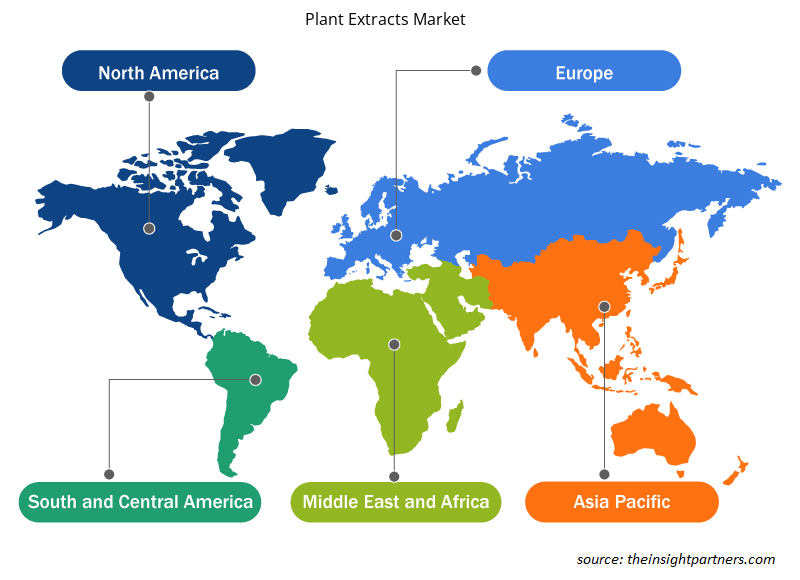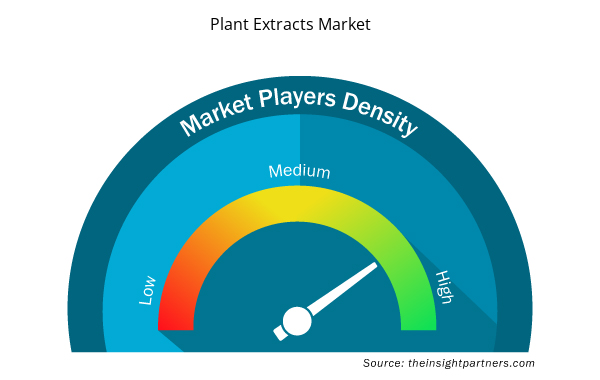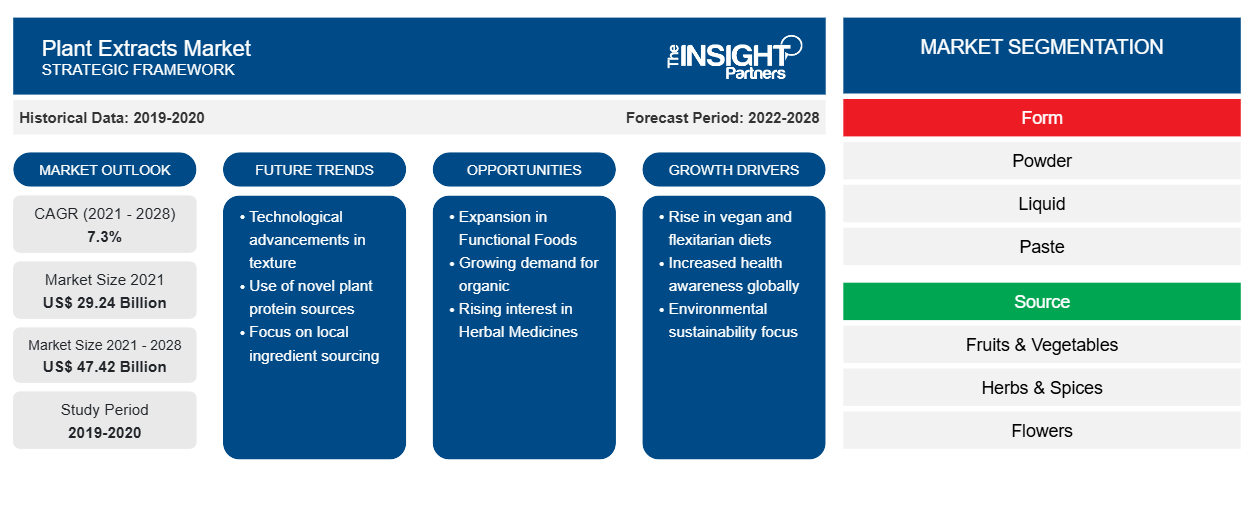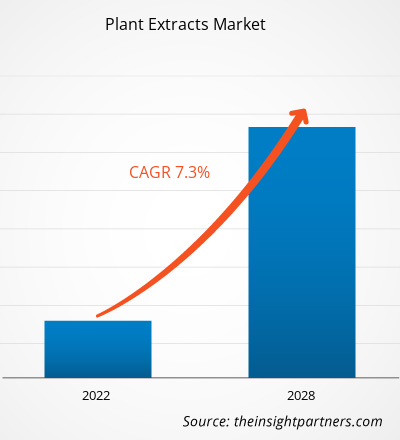植物提取物市场预计将从 2021 年的 292.3891 亿美元增长到 2028 年的 474.2144 亿美元;预计 2022 年至 2028 年的复合年增长率为 7.3%。
植物提取物是从植物组织中提取的,通常用溶剂(包括酒精或水)处理。提取物用作食品和其他消费品的成分,具有各种功能,例如改变风味、香气和营养品质。植物提取物在预防保健中发挥着重要作用,因为它们通过增强免疫系统来预防疾病的发生。
2021 年,亚太地区占据了植物提取物市场的最大份额。市场增长归因于对天然成分(尤其是香料和草药提取物)的需求不断增长,以及“清洁标签产品”在该地区人口中的影响力不断增强。消费者在食品和饮料中寻求植物成分的当前趋势是推动亚太国家植物提取物市场发展的重要因素之一。因此,植物提取物制造商正在亚太地区扩大业务。例如,2021 年 11 月 17 日,国际香精香料公司投资 8700 万美元在印度尼西亚卡拉旺建立了香精制造厂。嘉吉公司、ADM、Kerry Group Plc 和国际香精香料公司是积极在该地区运营的公司之一。这些因素预计将在未来几年推动亚太植物提取物市场的增长。
定制此报告以满足您的需求
您可以免费定制任何报告,包括本报告的部分内容、国家级分析、Excel 数据包,以及为初创企业和大学提供优惠和折扣
- 获取此报告的关键市场趋势。这个免费样品将包括数据分析,从市场趋势到估计和预测。
COVID-19 疫情对植物提取物市场的影响
2020 年初,COVID-19 疫情给许多行业带来了前所未有的挑战。各国政府根据世卫组织和各国卫生部的指导方针实施的封锁、边境限制、旅行禁令、生产停工和其他安全措施阻碍了制造业的运营。然而,COVID-19 疫情对市场产生了积极影响,因为消费者越来越多地寻求天然、更安全的替代品来保持健康并增强免疫系统。此外,疫情还增加了对植物提取物在药物和增强免疫力的食品或饮料中的应用研究。例如,2020 年 2 月,泰国传统医学部和政府制药组织签署了一份谅解备忘录 (MoU),以研究药用植物穿心莲提取物,着眼于开发一种抑制 COVID-19 的药物。此外,制造商数量的增加和消费者对草药产品和补充剂的偏好推动了植物提取物市场的增长。
市场洞察
食品和饮料行业对天然成分的需求不断增长
草本和天然产品因其健康益处而越来越受欢迎。此外,消费者愿意为不含合成成分的产品支付高价。此外,他们越来越喜欢不含合成香料、色素和其他食品添加剂的食品和饮料产品。此外,消费者注重整体和有意识的消费,喜欢含有合乎道德的成分的产品。消费者越来越意识到食用合成成分对健康的不利影响,推动了食品和饮料行业对天然成分的需求。此外,植物提取物在行业中越来越多地用作抗氧化剂、抗菌剂和延长保质期的剂。所有这些因素预计将在预测期内推动植物提取物市场的增长。
基于表单的洞察
根据形态,植物提取物市场分为粉末、液体和糊状。液体部分预计在预测期内占据最大份额。液体提取物是植物提取物的主要可用形式,因为它比其他形式需要的加工更少。液体提取物的其他一些优点包括吸收快、混合灵活、保质期更长,预计这将在未来几年推动其需求。
基于来源的洞察
根据来源,植物提取物市场细分为水果和蔬菜、草药和香料、花卉和其他。草药和香料部分预计在预测期内占据最大份额。草药和香料提取物,包括姜黄、香菜、圣罗勒和薰衣草,长期以来一直被广泛用于阿育吠陀。人们对使用阿育吠陀疗法来保持皮肤、头发和指甲健康表现出浓厚的兴趣。因此,草药和香料提取物在化妆品行业的使用量不断增加,预计将促进草药和香料部分的市场增长。此外,Kerry Group plc 为流行的食品、制药和芳香疗法行业提供广泛的香草、咖啡因和不同茶类产品组合,如草药和香料,以满足消费者的需求。这一因素促进了草药和香料部分植物提取物市场的增长。
基于应用的洞察
根据应用,植物提取物市场细分为食品和饮料、药品和保健品、个人护理等。预计在预测期内,个人护理细分市场将实现最高的复合年增长率。植物提取物广泛用于治疗皮肤病,以促进慢性伤口愈合、加速组织再生和治疗寻常痤疮或斑块性银屑病。个人护理行业对植物成分的使用不断增加,预计将在预测期内推动该细分市场的市场增长。此外,近年来,随着人们对合成香料的健康担忧日益增加,许多消费者寻求在香水中加入安全和天然的成分,因此他们的偏好转向天然香水。
Sensient Technologies Corporation、Givaudan SA、Symrise、Dohler、Indesso、Synergy Flavours、International Flavors and Fragrances Inc.、Kerry Group Plc、Ingredion Inc. 和 Kemin Industries, Inc. 是植物提取物市场的主要参与者。这些参与者致力于开发降低健康风险的产品,以满足新兴趋势并遵守监管框架。他们参与并购、业务扩张和合作,以扩大市场份额。
植物提取物市场区域洞察
Insight Partners 的分析师已详尽解释了预测期内影响植物提取物市场的区域趋势和因素。本节还讨论了北美、欧洲、亚太地区、中东和非洲以及南美和中美洲的植物提取物市场细分和地理位置。

- 获取植物提取物市场的区域特定数据
植物提取物市场报告范围
| 报告属性 | 细节 |
|---|---|
| 2021 年市场规模 | 292.4亿美元 |
| 2028 年市场规模 | 474.2亿美元 |
| 全球复合年增长率(2021 - 2028) | 7.3% |
| 史料 | 2019-2020 |
| 预测期 | 2022-2028 |
| 涵盖的领域 | 按形式
|
| 覆盖地区和国家 | 北美
|
| 市场领导者和主要公司简介 |
|
植物提取物市场参与者密度:了解其对业务动态的影响
植物提取物市场正在快速增长,这得益于终端用户需求的不断增长,而这些需求又源于消费者偏好的不断变化、技术进步以及对产品优势的认识不断提高等因素。随着需求的增加,企业正在扩大其产品范围,进行创新以满足消费者的需求,并利用新兴趋势,从而进一步推动市场增长。
市场参与者密度是指在特定市场或行业内运营的企业或公司的分布情况。它表明在给定市场空间中,相对于其规模或总市场价值,有多少竞争对手(市场参与者)存在。
在植物提取物市场运营的主要公司有:
- Sensient 技术公司
- 奇华顿公司
- 德之馨
- 多勒
- 因德索
免责声明:上面列出的公司没有按照任何特定顺序排列。

- 了解植物提取物市场顶级关键参与者概况
报告亮点
- 植物提取物市场的渐进式行业趋势可帮助参与者制定有效的长期战略
- 采取业务增长战略以确保发达市场和发展中市场的增长
- 2022 年至 2028 年植物提取物市场定量分析
- 全球植物提取物需求量估计
- 波特五力分析说明了行业内买家和供应商的效力
- 了解竞争市场状况的最新发展
- 市场趋势和前景以及影响植物提取物市场增长的因素
- 通过强调支撑商业利益的市场策略来协助决策过程,从而促进市场增长
- 不同节点植物提取物市场规模
- 市场和植物提取物行业动态的详细概述和细分
- 各地区增长规模及增长机遇
- 历史分析(2 年)、基准年、预测(7 年)及复合年增长率
- PEST 和 SWOT 分析
- 市场规模价值/数量 - 全球、区域、国家
- 行业和竞争格局
- Excel 数据集



Report Coverage
Revenue forecast, Company Analysis, Industry landscape, Growth factors, and Trends

Segment Covered
This text is related
to segments covered.

Regional Scope
North America, Europe, Asia Pacific, Middle East & Africa, South & Central America

Country Scope
This text is related
to country scope.
常见问题
Rising demand for plant extracts as natural flavours, colours, preservatives, aroma ingredients and increasing utilization of plant extracts for formulating natural products are some of the key driving factors for the plant extracts market.
Based on source, floral is the fastest-growing segment. The increasing demand of floral extracts in perfumery, cosmetic, and personal care industries is driving the segment’s growth. Moreover, a shift towards floral segment is observed due to customer preferences of mild and sweet tones obtained from floral extract.
Asia Pacific accounted for the largest share of the global plant extracts market due to the increasing demand of botanical, herbal or plant extracts, natural colorants and flavors in food, beverage, perfumery and personal care industries.
Based on the application, the food and beverages segment accounted for the largest revenue share. The growing application of botanical and herbal extracts in various food and beverages including bakery products, confectionery, snacks, frozen desserts, dairy products, meat products, among others is driving the segment growth.
The increasing demand for botanical extracts and natural additives with clean label claim, as a replacement for synthetic or artificial additives, is expected to provide lucrative growth opportunities to the global plant extracts market over the forecast period.
The major players operating in the global plant extracts market are Sensient Technologies Corporation; Givaudan S.A.; Symrise; Dohler; Indesso; Synergy Flavors; International Flavors & Fragrances, Inc.; Kerry Group Plc; Ingredion, Inc.; and Kemin Industries, Inc.; among others
Trends and growth analysis reports related to Consumer Goods : READ MORE..
The List of Companies - Plant Extracts Market
- Sensient Technologies Corporation
- Givaudan S.A.
- Symrise
- Dohler
- Indesso
- Synergy Flavors
- International Flavors & Fragrances, Inc.
- Kerry Group Plc
- Ingredion Inc.
- Kemin Industries, Inc.
The Insight Partners performs research in 4 major stages: Data Collection & Secondary Research, Primary Research, Data Analysis and Data Triangulation & Final Review.
- Data Collection and Secondary Research:
As a market research and consulting firm operating from a decade, we have published and advised several client across the globe. First step for any study will start with an assessment of currently available data and insights from existing reports. Further, historical and current market information is collected from Investor Presentations, Annual Reports, SEC Filings, etc., and other information related to company’s performance and market positioning are gathered from Paid Databases (Factiva, Hoovers, and Reuters) and various other publications available in public domain.
Several associations trade associates, technical forums, institutes, societies and organization are accessed to gain technical as well as market related insights through their publications such as research papers, blogs and press releases related to the studies are referred to get cues about the market. Further, white papers, journals, magazines, and other news articles published in last 3 years are scrutinized and analyzed to understand the current market trends.
- Primary Research:
The primarily interview analysis comprise of data obtained from industry participants interview and answers to survey questions gathered by in-house primary team.
For primary research, interviews are conducted with industry experts/CEOs/Marketing Managers/VPs/Subject Matter Experts from both demand and supply side to get a 360-degree view of the market. The primary team conducts several interviews based on the complexity of the markets to understand the various market trends and dynamics which makes research more credible and precise.
A typical research interview fulfils the following functions:
- Provides first-hand information on the market size, market trends, growth trends, competitive landscape, and outlook
- Validates and strengthens in-house secondary research findings
- Develops the analysis team’s expertise and market understanding
Primary research involves email interactions and telephone interviews for each market, category, segment, and sub-segment across geographies. The participants who typically take part in such a process include, but are not limited to:
- Industry participants: VPs, business development managers, market intelligence managers and national sales managers
- Outside experts: Valuation experts, research analysts and key opinion leaders specializing in the electronics and semiconductor industry.
Below is the breakup of our primary respondents by company, designation, and region:

Once we receive the confirmation from primary research sources or primary respondents, we finalize the base year market estimation and forecast the data as per the macroeconomic and microeconomic factors assessed during data collection.
- Data Analysis:
Once data is validated through both secondary as well as primary respondents, we finalize the market estimations by hypothesis formulation and factor analysis at regional and country level.
- Macro-Economic Factor Analysis:
We analyse macroeconomic indicators such the gross domestic product (GDP), increase in the demand for goods and services across industries, technological advancement, regional economic growth, governmental policies, the influence of COVID-19, PEST analysis, and other aspects. This analysis aids in setting benchmarks for various nations/regions and approximating market splits. Additionally, the general trend of the aforementioned components aid in determining the market's development possibilities.
- Country Level Data:
Various factors that are especially aligned to the country are taken into account to determine the market size for a certain area and country, including the presence of vendors, such as headquarters and offices, the country's GDP, demand patterns, and industry growth. To comprehend the market dynamics for the nation, a number of growth variables, inhibitors, application areas, and current market trends are researched. The aforementioned elements aid in determining the country's overall market's growth potential.
- Company Profile:
The “Table of Contents” is formulated by listing and analyzing more than 25 - 30 companies operating in the market ecosystem across geographies. However, we profile only 10 companies as a standard practice in our syndicate reports. These 10 companies comprise leading, emerging, and regional players. Nonetheless, our analysis is not restricted to the 10 listed companies, we also analyze other companies present in the market to develop a holistic view and understand the prevailing trends. The “Company Profiles” section in the report covers key facts, business description, products & services, financial information, SWOT analysis, and key developments. The financial information presented is extracted from the annual reports and official documents of the publicly listed companies. Upon collecting the information for the sections of respective companies, we verify them via various primary sources and then compile the data in respective company profiles. The company level information helps us in deriving the base number as well as in forecasting the market size.
- Developing Base Number:
Aggregation of sales statistics (2020-2022) and macro-economic factor, and other secondary and primary research insights are utilized to arrive at base number and related market shares for 2022. The data gaps are identified in this step and relevant market data is analyzed, collected from paid primary interviews or databases. On finalizing the base year market size, forecasts are developed on the basis of macro-economic, industry and market growth factors and company level analysis.
- Data Triangulation and Final Review:
The market findings and base year market size calculations are validated from supply as well as demand side. Demand side validations are based on macro-economic factor analysis and benchmarks for respective regions and countries. In case of supply side validations, revenues of major companies are estimated (in case not available) based on industry benchmark, approximate number of employees, product portfolio, and primary interviews revenues are gathered. Further revenue from target product/service segment is assessed to avoid overshooting of market statistics. In case of heavy deviations between supply and demand side values, all thes steps are repeated to achieve synchronization.
We follow an iterative model, wherein we share our research findings with Subject Matter Experts (SME’s) and Key Opinion Leaders (KOLs) until consensus view of the market is not formulated – this model negates any drastic deviation in the opinions of experts. Only validated and universally acceptable research findings are quoted in our reports.
We have important check points that we use to validate our research findings – which we call – data triangulation, where we validate the information, we generate from secondary sources with primary interviews and then we re-validate with our internal data bases and Subject matter experts. This comprehensive model enables us to deliver high quality, reliable data in shortest possible time.


 获取此报告的免费样本
获取此报告的免费样本